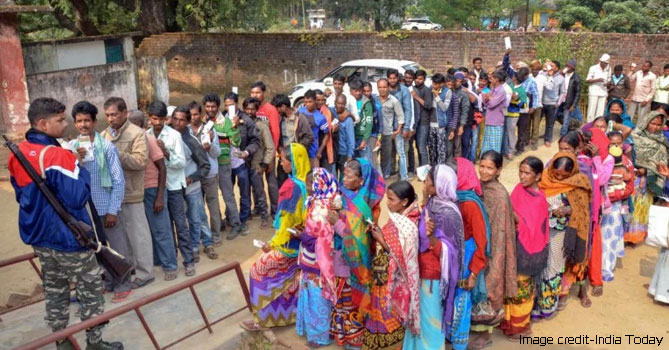Why is Chandrababu Naidu meeting opposition leaders in Delhi?
The capital city of Delhi is right now the hottest place in the country, and it’s not the weather. With campaigning over, political activity and focus has now shifted to the capital where the opposition parties are discussing all possible result outcomes on 23 May and to find common ground for building a credible and workable coalition. The objective is one – removal of the Modi-led NDA from power but challenges of ideology, priority, self-interest, and ego, continue to remain.
Andhra Pradesh CM Chandrababu Naidu is parked in Delhi and has been holding closed-door meetings with several leaders including Congress president Rahul Gandhi, NCP leader Sharad Pawar, LJD leader Sharad Yadav, Delhi CM Arvind Kejriwal, CPI (M) leader Sitaram Yechury. On Saturday, he went to Lucknow to meet BSP leader Mayawati and SP leader Akhilesh Yadav.
In April, he met with Bengal CM Mamata Banerjee and joined her in two of her rallies in West Bengal. Mamata Banerjee reciprocated the gesture in joining Chandrababu Naidu for his rallies in A.P.
Chandrababu Naidu’s counterpart and rival Telangana CM K Chandrashekar Rao, too, has been busy trying to find takers for a third front without the Congress.
The reason for the opposition in moving ahead of the last round of voting is they do not want to lose out to the BJP as Congress learned the hard way during the Goa assembly polls. At the time, BJP was faster and managed the potential partners better than the Congress who missed coming to power despite having the maximum seats.
The opposition senses the BJP-led NDA may not get a clear majority and realize the BJP will need the help of other regional parties beyond the NDA.
The opposition has seen how Amit Shah can aggressively negotiate with partners in speed and terms, and so, they are taking preemptive steps to stave off an aggressive BJP in the post-result scenario.
Campaigning over, how PM Modi compared with Rahul Gandhi
NDTV has come out with an interesting comparison between PM Modi and Rahul Gandhi’s poll campaign.
How do they compare in focus and regional coverage?
PM Modi
PM Modi followed a closely developed strategic plan based on ground reality and emerging possibility. This is reflected in his choice of states and focus. He addressed a massive 144 rallies and roadshows across India, but 40 percent of these were in U.P, West Bengal and Odisha.
Why these states?
Uttar Pradesh holds the maximum Lok Sabha seats – 80 and winning maximum seats here is politically important and a strategic imperative. In 2014 general elections, BJP won 71 of the 80 seats. In 2017 assembly elections, BJP won 325 of 403 seats, and the comfortable majority should have positioned BJP on strong ground.
However, the recent alliance between BSP-SP in U.P has thrown up a big challenge to the party. Also, Priyanka Gandhi’s presence and focus in eastern U.P have forced the BJP think-tank to increase their focus in U.P and deploy their trump card – PM Modi, to the maximum.
However, BJP realizes they have lost ground in U.P and are likely to win seats than in 2014. To makeup, the party expects a better chance in West Bengal to make up the possible seats lost in U.P. The BJP won 2 seats in 2014 in Bengal and is targeting 23 seats this year.
In 2014, the BJP managed to win just one of 21 seats in Odisha, and the party believes it has a good chance to make significant inroads in the state.
Rest of PM Modi’s rallies were distributed across several states.
Rahul Gandhi
Congress president Rahul Gandhi has addressed 125 rallies and roadshows across India, but his focus has been Uttar Pradesh, Madhya Pradesh, Rajasthan, and Kerala.
The focus on U.P was necessary since Congress failed to join the BSP-SP-RLD alliance and decided to fight it alone. Having unseated the BJP in M.P, Rajasthan, and Chhattisgarh in the recent assembly elections, the Congress president decided to try and consolidate gains in M.P and Rajasthan. Kerala was an afterthought after he chose to contest from Wayanad, in addition to Amethi.
The high stakes beyond the seats
All discussion and attention are on the number of seats each party will win in these elections, but it is the vote share that reveals the deeper picture and prepares political parties to develop their future strategy in each constituency.
Take BJP’s strategy in Bengal. In 2009, the party won one seat of 42 with a vote share of 6.14 percent. In 2014, BJP won just 2 seats but with a vote share significantly improving from 6.14 percent to 17.02 percent. Enough to give them the confidence to challenge a well-entrenched TMC in 2019. It is why PM Modi and Amit Shah have invested so much time and resource in West Bengal. The party needs a significantly improved performance here, and in Odisha, to make up for possible losses in U.P, M.P, Rajasthan, Chhattisgarh, Punjab, and the North East states.
If the BJP improves its vote share in both Bengal and Odisha but fails to bring in the targeted numbers, it will establish a platform to build upon in the next assembly elections in the states.
Keep an eye on vote shares of all parties in each seat.
Related Link:
17th General (Lok Sabha) Elections 2019 and Parliamentary Constituencies






